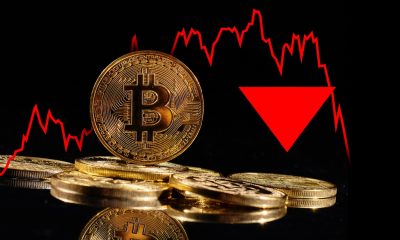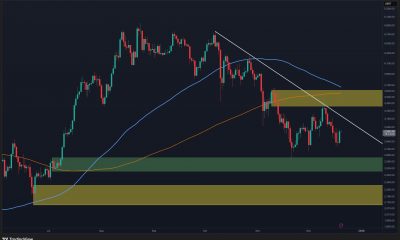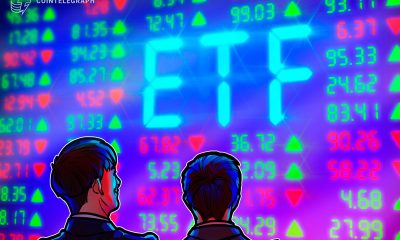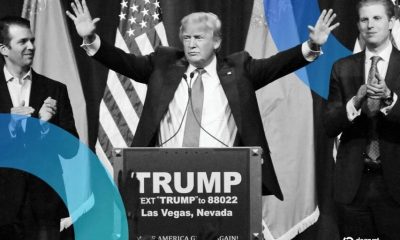

others
Gold tumbles as US Dollar appeal improves ahead of Powell speech – Crypto News
- Gold price drops to a near two-week low as investors channel funds into the US Dollar and bond yields rise.
- Geopolitical tensions stay more or less unchanged fading the appeal of Gold.
- Fed’s Kashkari acknowledges the need for more work to control inflation.
Gold price (XAU/USD) drops further as safe-haven demand diminishes amid no further escalation in geopolitical tensions. A recovery in the US Dollar and long-term bond yields further weigh on the precious metal.
The downside move in Gold, however, may be short-lived as investors see an end to the Federal Reserve’s (Fed) rate-tightening campaign, due to gradually easing consumer inflation and higher Treasury yields, which have tightened financial conditions significantly.
Commentary from Federal Reserve Chairman Jerome Powell on Wednesday could drive further action in the US Dollar and bond markets. Powell may give an idea of whether investors should expect more interest rate hikes this year to ensure a return of inflation to the Fed’s 2% target.
Fed Governor Lisa Cook said that the current interest rate policy is sufficiently restrictive to achieve price stability on Monday; Fed’s Kashkari, on the other hand, reportedly said the opposite in a Wall Street Journal article published on the same day.
Daily Digest Market Movers: Gold price appeal fades amid delay in Israel attack
- Gold price extends correction to near $1,970.00 amid a recovery in the US Dollar and bond yields as Federal Reserve policymakers line up to give guidance on inflation and interest rates this week.
- Gold price fades on an absence of significant escalation in Middle East tensions.
- Israeli Prime Minister Benjamin Netanyahu has allowed entry of humanitarian aid to and the exiting of hostages from Gaza, but rejected a general ceasefire. Geopolitical tensions would keep broader demand for Gold intact.
- The US Dollar Index (DXY) discovered buyers’ interest marginally below the crucial support of 105.00 after commentary from Minneapolis Fed Bank President Neel Kashkari. The commentary from Kashkari indicated that he is leaning towards raising interest rates further.
- Kashkari commented that the economy is performing well despite higher interest rates. He added that the central bank has much work to do to ensure price stability.
- Contrary to Kashkari, Fed Governor Lisa Cook said the current monetary policy is adequate to bring down inflation to 2%. Cook commented that the US financial system is healthy enough to tackle economic challenges.
- The Fed kept interest rates unchanged in the 5.25-5.50% last week for the second time in a row on expectations that higher US bond yields are significantly tightening financial conditions, slowing overall demand and price pressures.
- The correction in Gold could conclude sooner and a revival is highly likely as investors hope that the Fed is done with hiking interest rates.
- A slowdown in labor demand and a decline in the Services PMI has cemented hopes that interest rates won’t be hiked further.
- As per the CME Fedwatch tool, traders see an 85% chance for interest rates remaining unchanged till the year-end.
- Meanwhile, 10-year US Treasury yields managed to attain a firm footing near 4.60% as investors shifted focus to the speech from Fed Chair Jerome Powell, scheduled for Wednesday.
- Powell is expected to provide guidance on the requirement of more interest rate hikes to ensure the achievement of price stability or a time period for which rates will remain elevated and some glimpse into the performance of the economy in the fourth quarter of 2023.
- Before Powell, speeches from other Fed policymakers: Christopher Waller and John C. Williams will be keenly watched.
Technical Analysis: Gold price falls sharply below $1,970
Gold price extends downside marginally below $1,970.00 after several failed attempts of stabilization above the psychological resistance of $2,000. The precious metal is exposed to the 20-day Exponential Moving Average (EMA), which trades around $1,960.00. The broader trend is still bullish as the 200-day EMA is sloping higher. Momentum oscillators demonstrate that the bullish momentum has faded.
Fed FAQs
Monetary policy in the US is shaped by the Federal Reserve (Fed). The Fed has two mandates: to achieve price stability and foster full employment. Its primary tool to achieve these goals is by adjusting interest rates.
When prices are rising too quickly and inflation is above the Fed’s 2% target, it raises interest rates, increasing borrowing costs throughout the economy. This results in a stronger US Dollar (USD) as it makes the US a more attractive place for international investors to park their money.
When inflation falls below 2% or the Unemployment Rate is too high, the Fed may lower interest rates to encourage borrowing, which weighs on the Greenback.
The Federal Reserve (Fed) holds eight policy meetings a year, where the Federal Open Market Committee (FOMC) assesses economic conditions and makes monetary policy decisions.
The FOMC is attended by twelve Fed officials – the seven members of the Board of Governors, the president of the Federal Reserve Bank of New York, and four of the remaining eleven regional Reserve Bank presidents, who serve one-year terms on a rotating basis.
In extreme situations, the Federal Reserve may resort to a policy named Quantitative Easing (QE). QE is the process by which the Fed substantially increases the flow of credit in a stuck financial system.
It is a non-standard policy measure used during crises or when inflation is extremely low. It was the Fed’s weapon of choice during the Great Financial Crisis in 2008. It involves the Fed printing more Dollars and using them to buy high grade bonds from financial institutions. QE usually weakens the US Dollar.
Quantitative tightening (QT) is the reverse process of QE, whereby the Federal Reserve stops buying bonds from financial institutions and does not reinvest the principal from the bonds it holds maturing, to purchase new bonds. It is usually positive for the value of the US Dollar.
-
others1 week ago
Japan Foreign Investment in Japan Stocks up to ¥528.3B in December 12 from previous ¥96.8B – Crypto News
-

 Technology1 week ago
Technology1 week agoOnePlus 15R vs Pixel 9a: Which phone is the best buy under ₹50,000? Display, camera, processor and more compared – Crypto News
-

 Blockchain6 days ago
Blockchain6 days agoThis Week in Stablecoins: Winning the Back Office – Crypto News
-

 Technology6 days ago
Technology6 days agoApple iPhone 16 price drops to ₹40,990 in Croma’s Cromtastic December Sale: How the deal works – Crypto News
-

 Technology6 days ago
Technology6 days agoApple iPhone 16 price drops to ₹40,990 in Croma’s Cromtastic December Sale: How the deal works – Crypto News
-
Business6 days ago
XRP Holders Eye ‘Institutional Grade Yield’ as Ripple Engineer Details Upcoming XRPL Lending Protocol – Crypto News
-
Business6 days ago
DOGEBALL Presale: A Boost to Bring P2E Games Back into the Spotlight – Crypto News
-
others6 days ago
XRP Holders Eye ‘Institutional Grade Yield’ as Ripple Engineer Details Upcoming XRPL Lending Protocol – Crypto News
-

 Technology6 days ago
Technology6 days agoApple iPhone 16 price drops to ₹40,990 in Croma’s Cromtastic December Sale: How the deal works – Crypto News
-

 others1 week ago
others1 week agoAustralian Dollar loses as US Dollar advances before Michigan Sentiment Index – Crypto News
-

 Technology5 days ago
Technology5 days agoApple iPhone 15 price drops to ₹36,490 in Croma Cromtastic December Sale: How the deal works – Crypto News
-

 Blockchain1 week ago
Blockchain1 week agoBlockchain’s Institutional Future Is Private and Permissioned – Crypto News
-
Business6 days ago
125 Crypto Firms Mount Unified Defense as Banks Push to Block Stablecoin Rewards – Crypto News
-

 Blockchain5 days ago
Blockchain5 days agoLitecoin Follows Bitcoin’s Momentum, But Resistance Looms At $79.60 – Crypto News
-

 Cryptocurrency1 week ago
Cryptocurrency1 week agoCapital gets selective – Blockworks – Crypto News
-
others1 week ago
Low-Fee vs. High-Leverage – How to Choose the Optimal Exchange for Your Trading Strategy? – Crypto News
-

 Technology1 week ago
Technology1 week agoUS Puts Tech Deal With UK on Hold – Crypto News
-

 Blockchain1 week ago
Blockchain1 week agoCiti Says Identity Is the New Gatekeeper for Financial Blockchains – Crypto News
-
Technology6 days ago
Michael Saylor Sparks Debate Over Bitcoin’s Quantum Risk as Bitcoiners Dismiss It as ‘FUD’ – Crypto News
-

 Blockchain5 days ago
Blockchain5 days agoCrypto Market Sentiment Not Fearful Enough For Bottom: Santiment – Crypto News
-

 Blockchain5 days ago
Blockchain5 days agoLitecoin Follows Bitcoin’s Momentum, But Resistance Looms At $79.60 – Crypto News
-

 others1 week ago
others1 week agoJapanese Yen strengthens as BoJ rate hike speculation grows – Crypto News
-
Metaverse1 week ago
How companies are using AI to squeeze more from your wallet – Crypto News
-

 Blockchain1 week ago
Blockchain1 week agoBitcoin on Track For 4th Annual Decline Despite Crypto Adoption – Crypto News
-

 Cryptocurrency1 week ago
Cryptocurrency1 week agoWhy quantum computing is becoming a real concern for Bitcoin – Crypto News
-
Business7 days ago
Breaking: VanEck Discloses Fees and Staking Details for its Avalanche ETF – Crypto News
-

 Blockchain6 days ago
Blockchain6 days agoCoinbase Launches Service to Help Businesses Create Tokens – Crypto News
-

 Cryptocurrency6 days ago
Cryptocurrency6 days agoBTC at $143K, ETH above $4000: Citi issues bullish price forecasts as crypto market continues to struggle – Crypto News
-
Business6 days ago
Ethereum Faces Selling Pressure as BitMEX Co-Founder Rotates $2M Into DeFi Tokens – Crypto News
-

 Cryptocurrency6 days ago
Cryptocurrency6 days agoIs ETH Ready for Sustained Recovery or Another Rejection Looms? – Crypto News
-

 Cryptocurrency5 days ago
Cryptocurrency5 days agoXRP Could Add Zero If Rally Is Short-Lived – Crypto News
-

 Blockchain5 days ago
Blockchain5 days agoCrypto Market Sentiment Not Fearful Enough For Bottom: Santiment – Crypto News
-

 Technology4 days ago
Technology4 days agoSamsung Galaxy S25 Ultra price drops to ₹69,999 at Croma Cromtastic December Sale? Here’s how the deal works – Crypto News
-

 Metaverse1 week ago
Metaverse1 week agoSpaceX has two aces up its sleeve in the battle to put AI data centers in space – Crypto News
-

 Cryptocurrency1 week ago
Cryptocurrency1 week agoBitcoin and Ethereum Wobble as US Reports Highest Unemployment Rate Since 2021 – Crypto News
-

 others1 week ago
others1 week agoSEC Crypto Roundtable Questions Whether Americans Can Transact Without Surrendering Privacy – Crypto News
-

 Blockchain1 week ago
Blockchain1 week agoMastercard, BlackRock Join Middle East-Focused Blockchain Effort – Crypto News
-

 Technology7 days ago
Technology7 days agoFrom chibi to plushie: 7 Must-try AI portraits you can create with GPT Image 1.5 – Crypto News
-

 Technology7 days ago
Technology7 days agoFrom chibi to plushie: 7 Must-try AI portraits you can create with GPT Image 1.5 – Crypto News
-
Business6 days ago
Bitcoin Price Alarming Pattern Points to a Dip to $80k as $2.7b Options Expires Today – Crypto News
-

 Metaverse6 days ago
Metaverse6 days agoAI Tool of the Week: Transform marketing concepts instantly. – Crypto News
-

 Blockchain6 days ago
Blockchain6 days agoBlackRock’s IBIT Ranks 6th in ETF Flows Despite Negative Returns – Crypto News
-

 others6 days ago
others6 days agoElliott Wave, seasonality, and cycles indicate more upside – Crypto News
-

 others6 days ago
others6 days agoElliott Wave, seasonality, and cycles indicate more upside – Crypto News
-

 Cryptocurrency6 days ago
Cryptocurrency6 days agoCrypto Industry Must Make Progress Before Trump Leaves Office: Etherealize Co-Founder – Crypto News
-

 Cryptocurrency6 days ago
Cryptocurrency6 days agoCrypto Industry Must Make Progress Before Trump Leaves Office: Etherealize Co-Founder – Crypto News
-

 Blockchain6 days ago
Blockchain6 days agoBlockchain and AI Vibe-Coding To Dethrone Amazon Web Servies: Crypto exec – Crypto News
-

 Blockchain5 days ago
Blockchain5 days agoBanks Need XRP To Be Pricier—Here’s Why A Finance Expert Says So – Crypto News
-

 Technology5 days ago
Technology5 days agoSam Altman says AI’s next big breakthrough will be memory, not reasoning – Crypto News
-

 Technology1 week ago
Technology1 week agoOnePlus 15R and OnePlus Pad Go 2 launching in India tomorrow: How to watch live-stream, expected price, specs and more – Crypto News








